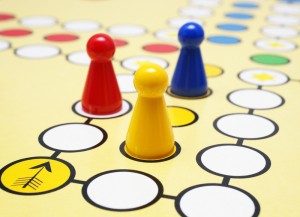By Mercedes Stanley
 One of my favorite ways to help engage families in therapy is to use board games.
One of my favorite ways to help engage families in therapy is to use board games.
I use “Sorry!” For older kids [8 and up] and I use “Candyland” and/or “Chutes and Ladders” for younger kids [7 and under]. Both games have fairly simple rules. And, most families have heard of them and are familiar with the mechanics of the games. That saves time on having to explain.
CandyLand/Chutes & Ladders
With these games, there is a focus on numbers and reading. There is also a focus on taking turns and having to do what is asked of the player [such as go back a few steps ro fall down a ladder]. I love playing this game with a family because it shows me the following:
Family dynamics
I assess the amount of family/caregiver involvement in two ways: if the caregiver agrees to play and how invested in the game the caregiver appears to be. Sometimes caregivers have a difficult time just playing with their child. I encourage them that not all interactions with their child have to be about caregiving, some can be just about having fun!
Protective/Risk Factors in the Family
One thing that shows up with caregivers/parents of small children while playing this game is how the parent interacts with the child during the game. Some parents tend to be more forceful, and will often yell at the child for not playing the game correctly. While some parents will allow the child to play at will with no respect for the rules of the game. This gives me insight into the families protective factors [factors that help shield the family during times of stress] and risk factors [factors that exacerbate the stress of a family].
Child’s Coping Skills
The two games challenge children to lay fair and follow rules. For the age range these games are aimed at, fairness and rules can be hard to teach. However, I try to assess how a child responds to being redirected during the game as well as how the child redirects others when they feel something has gone amiss in the game.
Academic strengths and weaknesses of the child
The two games require that a child know basic shapes, colors, and can recognize numbers and letters. Oftentimes, through playing these games I am able to assess where the child is academically, and work with parents to facilitate activities that bolster the strengths and improve areas of weakness.
Sorry!
This games is so much fun and it’s also really good to help older kids loosen up during a family session. I usually introduce this games after about a month of working with the family bc I know that playing games in a session is not always something an older kids wants to do with their parent. But, once I’ve got a feel for the stability of the family, I can introduce it. This game is all about making decisions: each card that the player picks tell them to move their game piece somewhere on the board. Some of the cards just state the number of spaces to move, but some ask the player to make the decision to take a few steps back, or to bump another players piece back to the beginning of the board. It can get pretty interesting to watch families deal with the card instruction. This games helps show me the following:
Family dynamics
The object of the game is to get your pieces around the board and back to the home base. While watching families interact during this game, I am able to assess what role each member plays: who’s more dominant, who’s more passive, or who’s more quiet. This allows me to develop a treatment plan based on how the family understands it’s own family system. It also gives me a glimpse into the possible dysfunction within the family system that could be triggering the identified client.
Level of enmeshment/disconnect
This level of assessment ties into Family Dynamics because along with using the game to assess for dysfunction in the family system, I also use the rules of the game to assess for level of enmeshment [too tight with no clear boundaries] and disconnect [too distant with lots of individuality]. As stated, the game rules require players to use cards to move across the board. However, some cards ask the player to choose between moving another player back to the starting mark or taking steps backwards on the board. The ways in which the family member makes the choice display how well boundaries in the family system are established [i.e., does mom always decide to sacrifice a few steps back to help son along; does sibling decide to send his brother back because he craves winning over supporting his younger siblings pride].
Academic strengths and weaknesses of the child
This games requires a lot of reading [due to the cards] and counting. Since the game is aimed towards older children, I ask the family member to read their cards aloud. This allows both me and the caregiver to assess the child’s academic process. Some children have a difficult time reading aloud in class, but are more inclined to read when playing a game. I explain to the parent after the game is over what I observed about the identified clients’ strengths appear to be and how to encourage them, as well as what the weakness may be and how to help build up those skills.
As a clinician, I think board games help the family to relax and not think about the therapy as much. I also use the games as a form of nonverbal assessment of the family. Man of the issues that a family, and most likely the child, holds are not spoken or are subconsciously hidden. The neutrality of these games helps me to identify some of the family’s main strengths [such as teamwork and empathy towards each other], which I use to help build broken bonds. But, I can also observe the family’s weaknesses [such as anger towards each other or enmeshment], which allows me to decrease the amount of stress the family has on its system.
Guest Blogger Biography
 Mercedes Stanley, MSW is the founder of a parenting skills program, The Parenting Skill. She is also a clinical therapist at the Los Angeles Child Guidance Clinic in Los Angeles, CA working with families and children with severe emotional disturbances (SED). She received her MSW from the University of Southern California and BA in Psychology from UCLA. You can read more about her parenting program, The Parenting Skill, at http://theparentingskill.com.
Mercedes Stanley, MSW is the founder of a parenting skills program, The Parenting Skill. She is also a clinical therapist at the Los Angeles Child Guidance Clinic in Los Angeles, CA working with families and children with severe emotional disturbances (SED). She received her MSW from the University of Southern California and BA in Psychology from UCLA. You can read more about her parenting program, The Parenting Skill, at http://theparentingskill.com.
